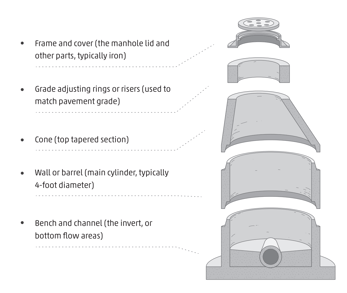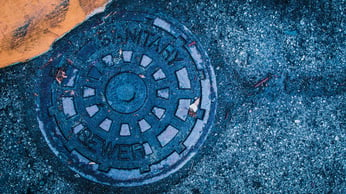Manholes are vertical underground confined spaces used by utility personnel as a point of access to a sewer system.
Sewer systems are built underground with pipes that carry waste from homes and other buildings to a place of treatment or disposal. Part of maintaining a sewer system is providing frequent inspection, cleaning and repairs. Utility crews use manholes to gain closer access to pipes or other parts of the underground system to meet those needs.
Manhole Design

There are three different types of manholes: shallow, normal and deep. “Normal” manholes are typically 4- to 5-feet deep and wide enough for the average person to fit in. "Shallow" manholes are 2- to 3-feet deep, often placed at the start of a sewer branch and in areas with low traffic. Manholes with a depth greater than 5-feet are considered "deep" and usually have an entry method like a ladder built-in, as well as a heavier cover.
Manholes are designed with a cover or lid and comprised of grade adjusting rings, a top tapered section called the cone, a main cylinder section called the wall or barrel, and a bench and channel where the waste flows through.
In the U.S., most manholes and manhole covers are circular, though rectangular or square manholes are common in other parts of the world. They are mostly located along streets and are intentionally installed in areas where the sewer line may change directions, pipe size or face a junction.
History of Manholes
Manholes as we know them today have been in use since the mid-19th century but have evolved over time for increased safety and functionality. While they were originally built with bricks, manholes are most often built using concrete today, though some are made of plastic, fiberglass or a similar composite. Composite liners are more likely to be used in regions with a high risk of corrosion or in areas where exfiltration or infiltration into the line is common. Many manholes today are built aboveground first. These are typically referred to as precast manholes—designed to fit a dug-out space and assembled on site before being lowered into the ground.
Modern Day Use
While manholes were initially built to provide humans with access to pipes and other underground assets, these days they are more often used for equipment. Crews lower inspection cameras into manholes to gather CCTV footage and other equipment for cleaning or maintenance.

Using automated or remotely-driven equipment is more cost-effective and efficient. Just as importantly, keeping people above ground helps keep them safe and away from fumes, bacteria, debris and flow.
Though utilities are increasingly using manholes in new ways, they continue to provide essential access to underground pipes, whether it’s for workers or their equipment.
Quickview 360 is a lightweight manhole inspection camera that can be deployed by a single operator to complete a fully-automated, comprehensive scan in just five minutes. It uses twin HD cameras to capture 360-degree footage plus a rangefinder for precision. Request a free Quickview 360 demo today:

